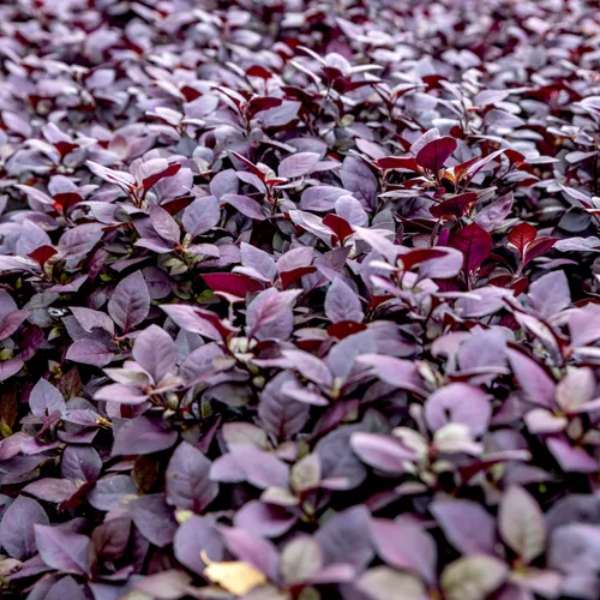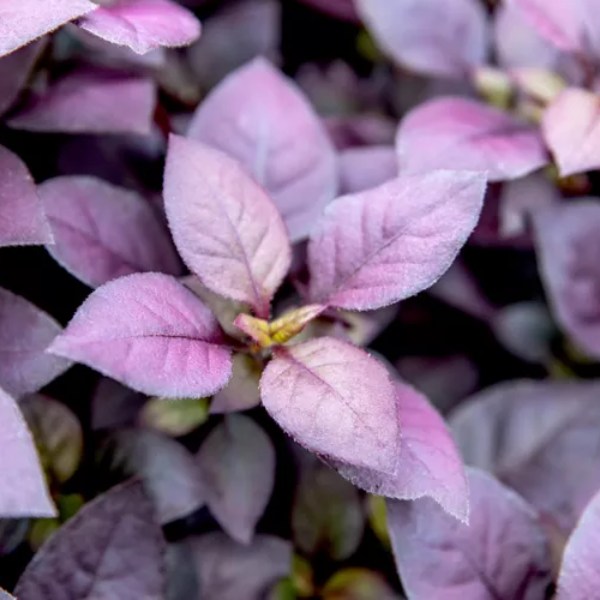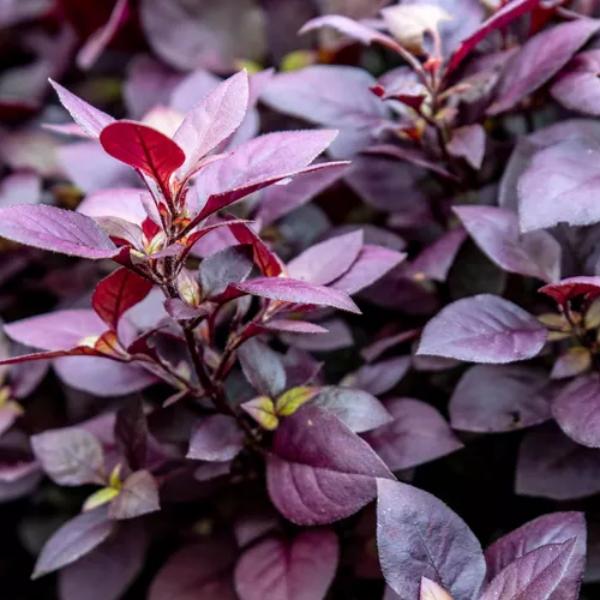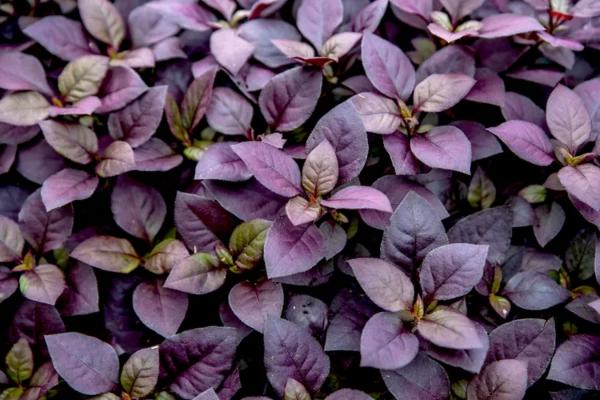If you’re looking for a plant that will add beauty and uniqueness to your garden, you might like a fast-growing eye catcher such as joyweed, also known as Joseph’s coat. With a wide variety of colors and sizes, the variegated foliage is definitely the real star here. Joyweed is winter hardy in USDA zones 10 and 11. It only returns yearly as a perennial in the hottest areas of the US. This plant is often kept as an annual or a houseplant in a bright window.
The leaves are dark green and feature pink, orange, red, yellow, copper, or even purple splotches. Some are of different colors dappled in one plant. Joseph’s coat also produces flowers, but the already vibrant plant outshines the mini accents blooms.
Grow these plants indoors in late winter and after the last frost date, you can transplant them outdoors. If you’re a beginner who loves gardening, this plant is a must-have since it is super easy to care for and grow. You have to give it water during drought and fertilizer monthly during the spring and summer when it is in its active growing season. There are a few varieties of joyweed that act as a perfect groundcover while there are some that can grow as tall as three feet. Known for its weedy growth habit, this tropical plant isn’t invasive in the United States.
Plant Attributes
- Common Name: Joyweed, Joseph’s coat
- Botanical Name: Alternanthera ficoidea
- Family: Amaranthaceae
- Plant Type: Perennial
- Mature Size: 6-12 in. tall, 1-1.5 ft. wide
- Sun Exposure: Full
- Soil Type: Moist, well-draining
- Soil pH: Acidic, neutral
- Bloom Time: Fall
- Flower Color: White
- Hardiness Zones: 10-11 (USDA)
- Native Area: South America, Central America
Joseph’s Coat Care
It is not at all hard to care for Joseph’s coat plus they are super easy to propagate. This low-maintenance plant requires well-draining soil and full sunlight if you’re growing it in a hotter climate. The best thing is that it is pest-resistant.
Also, Read Low maintainence Garden border Ideas || Best plants for garden edges
Light
These plants are native to hot, sunny climates so it is obvious that they need a lot of light to thrive. This plant is known for its bright foliage colors but the beautiful hues shine in full sun. While they can tolerate some shade, they may lose their color grow leggy, and have a lanky look.

Soil
Joyweed loves rich and fertile soil. Along with giving the plant the nutrients it requires to be healthy, it also creates a place for proper drainage. Before having this plant in your garden, amend the soil with lots of compost or organic matter.
Water
Joseph’s Coat needs lots of watering so water it at least an inch weekly. Both soggy soil and drought can kill this plant. Keep the soil moist as it helps to prevent any water-related problems. Before watering, check the first inch of the soil and if it does not feel dry, do not water it. If the plant doesn’t get enough water, it will wilt quickly but do not panic. They will come back to life quickly when you offer them water.
During the cold season, whether your joyweed is inside or outside, do not water it as frequently as you do during the summer. That means you will only water when the top 2 to 3 inches of the soil gets dry.
Temperature and Humidity
Being a native of the warm climates, Joseph’s coat can not withstand extremely cold temperatures. That’s why in zones 10 and 11, you can keep it outside all year long as a perennial. That being said, these plants are annuals in most of the USDA zones.
Joyweed is native to humid areas. That is the reason why regular watering is so important. Also, adding a layer of mulch to your outdoor plants will help retain the moisture in the soil.
Fertilizer
If you plant Joseph’s coat in rich soil, it doesn’t require any fertilizer. Adding too much fertilizer can damage the plant, ultimately killing it. But if the soil quality is poor, the plant would love feeding on liquid fertilizer, like fish emulsion, during the summer months.
Fertilizing the in-ground plant every two months is necessary. If the plant is in containers, fertilizing every two or three weeks is good. If you are not sure how much to use, follow product-level instructions. Skip fertilizing during the winter. Doing so will allow the plant to rest during its naturally slow-growing season.
Types of Joseph’s Coat
The Alternanthera genus has hundreds of varieties. They have lots of varieties and a wide range of colors and sizes. Some are green or gold while others can be dark maroon. While a few varieties are great as ground covers, some can reach up to 3 feet tall. Here are some of the popular varieties:
- Alternanthera ‘Partytime’: Vibrant pink, green, and yellow leaves
- Alternanthera ‘Gail’s Choice’: Grows as tall as 3 feet; boasts deep purple foliage
- Alternanthera ‘Little Ruby’: Great ground cover; showy ruby and burgundy foliage
Companion Plants for Joseph’s Coat
Planting joyweed next to plants that same water and light requirements is helpful. They do well near plants popular for their foliage like elephant ears, cannas, caladiums, and coleus. Their colorful leaves also complement flowers like impatiens, lobelia, begonias, and petunias.

Pruning
It would be good if you prune joyweed during summer as it helps the plant prevent it from being leggy. This also helps create the perfect opportunity to create more plants.
Propagating Joseph’s Coat
Propagating your Joseph’s Coat is super easy and it can be done by cuttings or divisions during its active growing stage i.e. spring and summer. If you don’t want to reduce the size of your current plant, you can also propagate it with cuttings.
Take notes from below to propagate your joyweed:
- Use pruning snips or sterilized scissors to snip at least a healthy two-inch stem. Other requirements are a clean jar or container with water. Alternatively, you will need a small pot with well-draining and moist soil.
- Cut the last leaves off the stem and partially submerge the cut end in the soil or water as per your preference.
- Keep the pot in a bright window.
- Within a few weeks, you’ll be able to see the roots in a clear jar of water. Check if the cutting is rooting in the soil, gently tug after a month. If the stem doesn’t pull out easily, it has developed roots.
The division helps a larger plant smaller. You divide the plant and its roots into smaller parts and then transplant them to grow in separate pots. If you want to propagate by division:
- Take a spade, soil, and a new container or planting location for your divided plant.
- Using the spade, dig out the parent plant and its roots. Then, divide the plant in half with the help of pruning snips or scissors. Roots need to be kept intact as much as possible. A little breakage won’t be a problem.
- Transplant each divided section into a pot that already has moistened soil or plant it in the garden that gets full sun throughout the day.
How to Grow Joseph’s Coat from Seed
While cutting and division is the easiest way to propagate joyweed, you can also grow them easily with seeds, with little effort. Sow the seeds indoors in late winter and keep the pot in a warm spot that receives bright light. Once they have sprouted, you can transplant them to a bright and sunny area outdoors after the frost danger is gone. Plant the plants at least 6 inches apart.
Potting and Repotting Joseph’s Coat
This plant grows easily in containers. If you plant them in hanging baskets, they are a sight to behold. While choosing a pot, take one that has proper drainage holes. Since soggy soil can quickly kill your plants, ample drainage is a must. The plant is a fast grower and if it outgrows its current pot, choose one size big pot and fill it with fresh and nourished soil before transferring the plant into it.
Overwintering
Joseph’s coat does well in a container and that is why keeping it in a container is a great option for you if you live in a place with tough winters. As the temperatures drop, move them inside as this plant can’t stand cold winters outdoors.

Common Pests and Plant Diseases
Joyweed, luckily, is not prone to insects or diseases but it can fall victim to mealybugs, aphids, and spider mites. If the infestation is bad, apply neem oil solution to the stems leaves, and soil. It is also likely to be susceptible to fungal and bacterial diseases like leaf spot diseases and root rot which mostly happens due to overwatering.
FAQs
Q: How do I care for Joseph’s coat indoors?
A: Provide as much direct sun as possible for brightly colored foliage. Joseph’s coat can tolerate a lot of direct sun. The plant is low maintenance and thrives in well-draining soil in containers.
Q: Does Joseph’s coat bloom?
A: Joseph’s coat is primarily grown for its foliage. The plant has clusters of small white blooms that attract bees and butterflies but are a relatively insignificant feature.
Q: How long does Joseph’s coat live?
A: Joseph’s coat is often grown as an annual because it cannot survive freezing temperatures. However, in USDA zones 10 and 11, it can live five years or longer.
Also, Read Top 10 Poisonous Plants to Keep Out of Your Garden for Dog’s Safety
